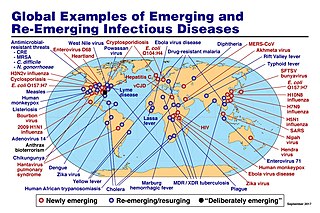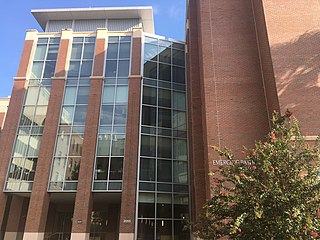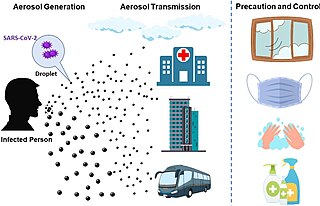
Methicillin-resistant Staphylococcus aureus (MRSA) is a group of gram-positive bacteria that are genetically distinct from other strains of Staphylococcus aureus. MRSA is responsible for several difficult-to-treat infections in humans. It caused more than 100,000 deaths worldwide attributable to antimicrobial resistance in 2019.

Severe acute respiratory syndrome (SARS) is a viral respiratory disease of zoonotic origin caused by the virus SARS-CoV-1, the first identified strain of the SARS-related coronavirus. The first known cases occurred in November 2002, and the syndrome caused the 2002–2004 SARS outbreak. In the 2010s, Chinese scientists traced the virus through the intermediary of Asian palm civets to cave-dwelling horseshoe bats in Xiyang Yi Ethnic Township, Yunnan.

In public health, contact tracing is the process of identifying persons who may have been exposed to an infected person ("contacts") and subsequent collection of further data to assess transmission. By tracing the contacts of infected individuals, testing them for infection, and isolating or treating the infected, this public health tool aims to reduce infections in the population. In addition to infection control, contact tracing serves as a means to identify high-risk and medically vulnerable populations who might be exposed to infection and facilitate appropriate medical care. In doing so, public health officials utilize contact tracing to conduct disease surveillance and prevent outbreaks. In cases of diseases of uncertain infectious potential, contact tracing is also sometimes performed to learn about disease characteristics, including infectiousness. Contact tracing is not always the most efficient method of addressing infectious disease. In areas of high disease prevalence, screening or focused testing may be more cost-effective.

An emerging infectious disease (EID) is an infectious disease whose incidence has increased recently, and could increase in the near future. The minority that are capable of developing efficient transmission between humans can become major public and global concerns as potential causes of epidemics or pandemics. Their many impacts can be economic and societal, as well as clinical. EIDs have been increasing steadily since at least 1940.

In health care facilities, isolation represents one of several measures that can be taken to implement in infection control: the prevention of communicable diseases from being transmitted from a patient to other patients, health care workers, and visitors, or from outsiders to a particular patient. Various forms of isolation exist, in some of which contact procedures are modified, and others in which the patient is kept away from all other people. In a system devised, and periodically revised, by the U.S. Centers for Disease Control and Prevention (CDC), various levels of patient isolation comprise application of one or more formally described "precaution".

Walter Ian Lipkin is the John Snow Professor of Epidemiology at the Mailman School of Public Health at Columbia University and a professor of Neurology and Pathology at the College of Physicians and Surgeons at Columbia University. He is also director of the Center for Infection and Immunity, an academic laboratory for microbe hunting in acute and chronic diseases. Lipkin is internationally recognized for his work with West Nile virus, SARS and COVID-19.

The Emerging Pathogens Institute (EPI) is an interdisciplinary research institution associated with the University of Florida. The institute focuses on fusing key disciplines to develop outreach, education, and research capabilities designed to preserve the region's health and economy, as well as to prevent or contain new and re-emerging diseases. Researchers within the institute work in more than 30 different countries around the world, with over 250 affiliated faculty members stemming from 11 University of Florida colleges, centers, and institutes. The 90,000-square-foot building includes laboratories and collaborative space for bioinformatics and mathematical modeling.

Airborne transmission or aerosol transmission is transmission of an infectious disease through small particles suspended in the air. Infectious diseases capable of airborne transmission include many of considerable importance both in human and veterinary medicine. The relevant infectious agent may be viruses, bacteria, or fungi, and they may be spread through breathing, talking, coughing, sneezing, raising of dust, spraying of liquids, flushing toilets, or any activities which generate aerosol particles or droplets.

A superspreading event (SSEV) is an event in which an infectious disease is spread much more than usual, while an unusually contagious organism infected with a disease is known as a superspreader. In the context of a human-borne illness, a superspreader is an individual who is more likely to infect others, compared with a typical infected person. Such superspreaders are of particular concern in epidemiology.

Coronavirus disease 2019 (COVID-19) is a contagious disease caused by the coronavirus SARS-CoV-2. The first known case was identified in Wuhan, China, in December 2019. The disease quickly spread worldwide, resulting in the COVID-19 pandemic.
Allison Joan McGeer is a Canadian infectious disease specialist in the Sinai Health System, and a professor in the Department of Laboratory Medicine and Pathobiology at the University of Toronto. She also appointed at the Dalla Lana School of Public Health and a Senior Clinician Scientist at the Lunenfeld-Tanenbaum Research Institute, and is a partner of the National Collaborating Centre for Infectious Diseases. McGeer has led investigations into the severe acute respiratory syndrome outbreak in Toronto and worked alongside Donald Low. During the COVID-19 pandemic, McGeer has studied how SARS-CoV-2 survives in the air and has served on several provincial committees advising aspects of the Government of Ontario's pandemic response.
Samira Mubareka is a Canadian microbiologist who is a clinical scientist at the Sunnybrook Health Sciences Centre in Toronto, Ontario. Her research considers the influenza virus, viral transmission and aerobiology. During the COVID-19 pandemic Mubareka isolated the genome of Severe acute respiratory syndrome coronavirus 2 in an effort to improve detection and diagnostics. She served as a member of the Ontario COVID-19 Science Advisory Table.
Helen Y. Chu is an American immunologist who is an assistant professor of medicine at the University of Washington. Her research considers maternal immunization, with a focus on influenza and respiratory syncytial virus. During the COVID-19 pandemic, Chu was the first physician to recognise community transmission of the coronavirus disease within the United States.

Andrea Ammon is a German physician and the current director of the European Centre for Disease Prevention and Control (ECDC), a European Union (EU) agency strengthening Europe's defence against infectious disease. She advised the German government on the SARS and Influenza A virus subtype H2N2 outbreaks.

Paul Anantharajah Tambyah, is a Singaporean doctor and professor of infectious diseases, a politician, and a writer. He is President of the Asia Pacific Society of Clinical Microbiology and Infection and also President of the International Society for Infectious Diseases. He is also the Chairman of the Singapore Democratic Party, a position he has held since September 2017.

The transmission of COVID-19 is the passing of coronavirus disease 2019 from person to person. COVID-19 is mainly transmitted when people breathe in air contaminated by droplets/aerosols and small airborne particles containing the virus. Infected people exhale those particles as they breathe, talk, cough, sneeze, or sing. Transmission is more likely the closer people are. However, infection can occur over longer distances, particularly indoors.

Saskia Popescu is an infectious disease epidemiologist and global health security expert in Phoenix, Arizona. She is an Assistant Professor of epidemiology at the University of Maryland, and holds academic appointments at the University of Arizona and George Mason University’s Schar School of Policy and Government, where she lectures on biopreparedness and outbreak response. Since the start of the Coronavirus disease 2019 pandemic, Popescu has worked to prepare for and mitigate the spread of the disease within healthcare and the entertainment industry, where she led the global epidemiology and infection prevention response for Netflix. She has been recognized for her communication efforts around the pandemic, as well as her work on the front lines in infection prevention and healthcare biopreparedness. Popescu currently is a Senior Fellow at the Council on Strategic Risks, addressing converging biological risks from biological weapons nonproliferation, biosecurity, emerging infectious diseases and ecological security, biopreparedness in private industry, and global health security vulnerabilities.

Yee-Sin Leo is a Singaporean physician. Leo is the executive director of the National Centre for Infectious Diseases and researches emerging infectious diseases. She has been in charge of Singapore's response to several outbreaks, including Nipah, SARS and COVID-19. In 2020, she was selected as one of the BBC's top 100 Women.
In the 2020 dengue outbreak in Singapore, a record-breaking number of dengue fever cases was reported in Singapore. This was part of the wider 2019–2020 dengue fever epidemic which also affected several neighbouring countries in Southeast Asia.
An occupational infectious disease is an infectious disease that is contracted at the workplace. Biological hazards (biohazards) include infectious microorganisms such as viruses, bacteria and toxins produced by those organisms such as anthrax.

















